Clos du Mont
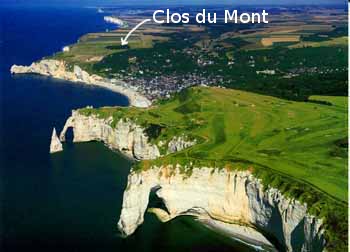
or The artists' farm
Located on the upstream cliff of the valley this norman enclosure was
the largest farm of Etretat.
A bank topped with a hedge of trees surrounds the farm, protecting it from
the wind and enclosing it in an intimate space.
At the end of a path which seems to lose itself over the cliff
behind,
you discover a fortress
of green with a few roof tops peeking
through the leaves.
The buildings of
the farm are laid out in square
around a wide
grassy yard of 100m x 100m.
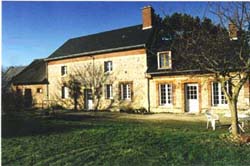 Almost
all the Impressionist painters (great as well as lesser known
ones) came here. This is why the people from below renamed it
"the artists' farm", rather than "la ferme d'amont" (the upstream
farm), to make fun of the farmer who made money off these
marginal types.
Almost
all the Impressionist painters (great as well as lesser known
ones) came here. This is why the people from below renamed it
"the artists' farm", rather than "la ferme d'amont" (the upstream
farm), to make fun of the farmer who made money off these
marginal types.
The house turns its back on the sea, from which came only
troubles. Farmers, working hard to make a living off the
land, were not interested in local scenery, painting or
tourism.
In winter, the sea blending in with the sky appears through rear
windows behind naked branches.
The barrier trees around the enclosure consist of sycomores, Austrian
pines ( introduced at the end of the 19th c ), oaks, hawthorns and
ashes. A few elms also remain.
The main house is made of stone and squared pebbles,
quite unusual in
this area where fishermens' houses and outbuildings
are made
of strips
of bricks with layers of crushed pebbles between them, as you can see
downtown.
This demontrates the wealth of the farm.
At the end of the 19th century, Etretat became the closest seaside to
reach by train from Paris. Daring people started the trend of
bathing in the sea and the town became a fashionable resort. Many rich
people built splendid holiday houses with large gardens on
the
sides of the valley and bought paintings from artists, who prefered
themselves to live more cheaply nearby. So, Corot, Monet,
Jonkind, Boudin and many other artists came here to work.
The farmer provided the artists with food and lodging (or
rented
them rooms for other purposes, rumor has it) and he kept their painting
equipment for them between their visits.
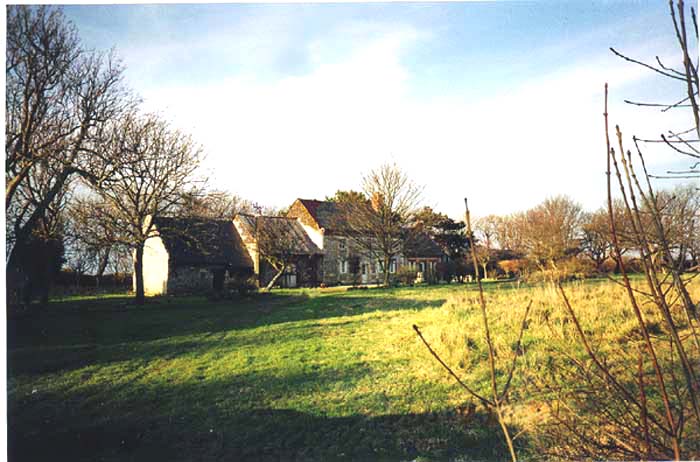 Originally, the enclosure had a pond
(now filled in) which nicely
reflected the bucolic scenery in different lights. The painters
competed drawing and painting this pond, producing works
which
were easy to sell. From time to time you can find some of these
paintings in auctions.
Originally, the enclosure had a pond
(now filled in) which nicely
reflected the bucolic scenery in different lights. The painters
competed drawing and painting this pond, producing works
which
were easy to sell. From time to time you can find some of these
paintings in auctions.
The invention of lead
tubes to hold oil paint allowed the artists to
work outside of their studios in direct contact with nature. They put
their "impressions" on the canvas at the expense of drawing pretty and
perfect paintings. The impressionist movement was born in Normandy.
They walked around painting ships, natural curiosities, skys, clouds
and the sun rising or setting.
Painter
Monet made his famous painting "la pie"
(the magpie) in front of the south barrier.
Author Maupassant wrote many short stories about this part of the
country which he loved. At least two stories probably took place in
this farm: "A Farm Girl" and "Miss Harriet" in
which the
author was inspired by the buried water tank which looks like a well,
just in front of the house (now covered over for safety).
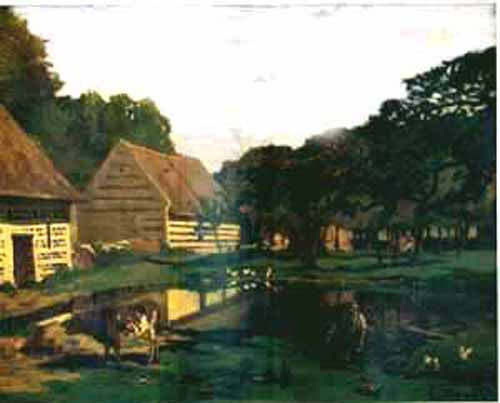 During
World War II, the farm was occupied by German soldiers. They dug
underground shelters to protect themselves against American and British
bombs. There is a square of concrete where cows where washed, not a V1
launcher base, as some have imagined.
During
World War II, the farm was occupied by German soldiers. They dug
underground shelters to protect themselves against American and British
bombs. There is a square of concrete where cows where washed, not a V1
launcher base, as some have imagined.
After World War
I, a new farmer who only wanted to farm, sent
away all the people who thought the farm was a pub. He shot
at walkers who were just asking for a
glass of
milk...they said. Life was hard with the liking for secrecy
which
characterizes the "cauchois" ie inhabitants of " pays de Caux" (Country
of Caux), encouraged by the physical layout of the farms which keep
their inhabitants in its own particular social and psychological
universe. Inside his enclosure, the farmer considered he
could do
as he pleased. After World War II, the mayor of Etretat had
to
come up to the farm to ask the farmer to give his workers
better
housing and treatment.
This
disposal is a danish one, half ecologic half military that was under
way in Danemark and can still be found there. This kind of
farm
lay out is Norman specific in contrary to usual
defensive
cluster found elsewhere in France.
On the cliff, water drains through the limestone and
cracks. Rain water from the roofs of the farm is
stored in
a tank which resembles a well (the one where Miss Harriett ended her
days..) This was a luxury as in many farms, the young milkmaid woke up
early to get the water on the pond's surface before the animals did.
As the drinking water was impure, with a curious hygienic
motive,
it was mixed with cider to make "besson" (drink) In the same
way apple brandy "Calvados", or "Calva" for short, was added
to
everything: coffee, cakes, even a drop in the baby's bottle, some
say...
The orchard then was very important and needed attention. The
entire yard was covered with apple trees. In this farm, everything
grows one or two weak later than down in the valleys. The cider here
was a bit acidic because of a lack of fructose, so that when the farm
was an artists' pub, the local people teased the farmer for his bitter
cider as well as for his dabbling artists.
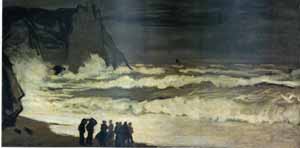 In most Norman farms, the dirt floors were covered with a cheap tiles,
nicely coloured but of bad quality, We have kept them in some rooms. As
there was no cellar, the walls became damp. During the 19th
century, inexpensive mortar was made of clay and lime chopped
straw and could be replaced again and again.
In most Norman farms, the dirt floors were covered with a cheap tiles,
nicely coloured but of bad quality, We have kept them in some rooms. As
there was no cellar, the walls became damp. During the 19th
century, inexpensive mortar was made of clay and lime chopped
straw and could be replaced again and again.
The ground floor was not used by humans; they lived on the
floor
between their animals down below and the hay-loft above their heads for
warmth.
The farm is located in a small trough of the cliff, which increases its
protection
against the wind. A stretch of good earth going through the
yard makes it extremely fertile: everything grows easily . At the
begining of April nature starts, in May leaves and flowers
suddenly explode into growth and it's easy to understand why
painters were attracted by such a human, ecological and aesthetic
place, located next to one of the loveliest tourist spot in
France.
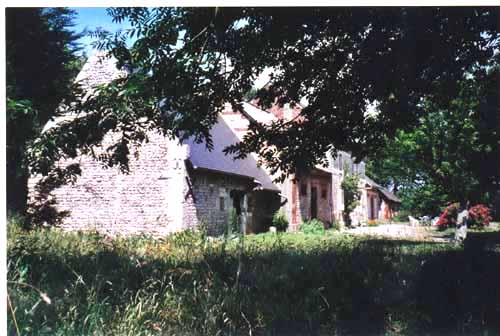


 Almost
all the Impressionist painters (great as well as lesser known
ones) came here. This is why the people from below renamed it
"the artists' farm", rather than "la ferme d'amont" (the upstream
farm), to make fun of the farmer who made money off these
marginal types.
Almost
all the Impressionist painters (great as well as lesser known
ones) came here. This is why the people from below renamed it
"the artists' farm", rather than "la ferme d'amont" (the upstream
farm), to make fun of the farmer who made money off these
marginal types. Originally, the enclosure had a pond
(now filled in) which nicely
reflected the bucolic scenery in different lights. The painters
competed drawing and painting this pond, producing works
which
were easy to sell. From time to time you can find some of these
paintings in auctions.
Originally, the enclosure had a pond
(now filled in) which nicely
reflected the bucolic scenery in different lights. The painters
competed drawing and painting this pond, producing works
which
were easy to sell. From time to time you can find some of these
paintings in auctions. 

